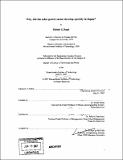| dc.contributor.advisor | Ernest Moniz and Rebecca Henderson. | en_US |
| dc.contributor.author | Rogol, Michael G | en_US |
| dc.contributor.other | Massachusetts Institute of Technology. Technology and Policy Program. | en_US |
| dc.date.accessioned | 2007-10-22T17:37:56Z | |
| dc.date.available | 2007-10-22T17:37:56Z | |
| dc.date.copyright | 2007 | en_US |
| dc.date.issued | 2007 | en_US |
| dc.identifier.uri | http://hdl.handle.net/1721.1/39335 | |
| dc.description | Thesis (S.M.)--Massachusetts Institute of Technology, Engineering Systems Division, Technology and Policy Program, 2007. | en_US |
| dc.description | Includes bibliographical references (leaves 175-181). | en_US |
| dc.description.abstract | The solar power sector grew quickly in Japan during the decade 1994 to 2003. During this period, annual installations increased 32-fold from 7MW in 1994 to 223MW in 2003, and annual production increased 22-fold, from 16MW in 1994 to 364MW in 2003. Over these years, the growth of Japan's solar power sector outpaced the global industry's growth, which is puzzling because Japan was in a recession during this period. At the same time, the U.S. was experiencing considerable economic expansion, yet the U.S. solar industry's growth was significantly slower than Japan's. This thesis focuses on the rapid development of Japan's solar power sector in order to address the central question, "Why did the solar power sector develop quickly in Japan?" To address this question, this thesis develops two comparative case studies: (1) Japan's solar power sector: 1994 to 2003 and (2) U.S. solar power sector: 1994 to 2003. These case studies provide detailed descriptions of the historical development of the solar power sectors in Japan and the U.S. based on data collected from International Energy Agency's PVPS program, Japan's New Energy Development Organization and the U.S. Energy Information Administration, among other sources. | en_US |
| dc.description.abstract | (cont.) A comparative analysis of these cases suggests that the rapid growth of Japan's solar power sector was enabled by interplay among (a) decreasing gross system prices price, (b) increasing installations, (c) increasing production and (d) decreasing costs. The second-order explanation for this interplay is that a mosaic of factors led to (a) decreasing prices, (b) increasing installations, (c) increasing production and (d) decreasing costs. This mosaic included the extrinsic setting (solar resource, interest rate, grid price), industrial organization (including the structure of the electric power sector and the structure within the solar power sector), demand-side incentives that drove down the "gap" with and provided a "trigger" for supply-side growth, and supply-side expansion that enabled significant cost reductions and price reductions that more than offset the decline in demand-side incentives. Within this complex interplay of numerous factors, roadmapping and industry coordination efforts played an important role by shaping the direction of Japan's solar power sector. This thesis concludes with "lessons learned" from Japan's solar power sector development, how these lessons may be applicable in a U.S. context and open questions for further research. | en_US |
| dc.description.statementofresponsibility | by Michael G. Rogol. | en_US |
| dc.format.extent | 181 leaves | en_US |
| dc.language.iso | eng | en_US |
| dc.publisher | Massachusetts Institute of Technology | en_US |
| dc.rights | M.I.T. theses are protected by copyright. They may be viewed from this source for any purpose, but reproduction or distribution in any format is prohibited without written permission. See provided URL for inquiries about permission. | en_US |
| dc.rights.uri | http://dspace.mit.edu/handle/1721.1/7582 | |
| dc.subject | Technology and Policy Program. | en_US |
| dc.title | Why did the solar power sector develop quickly in Japan? | en_US |
| dc.type | Thesis | en_US |
| dc.description.degree | S.M. | en_US |
| dc.contributor.department | Massachusetts Institute of Technology. Engineering Systems Division | |
| dc.contributor.department | Technology and Policy Program | |
| dc.identifier.oclc | 173518371 | en_US |

